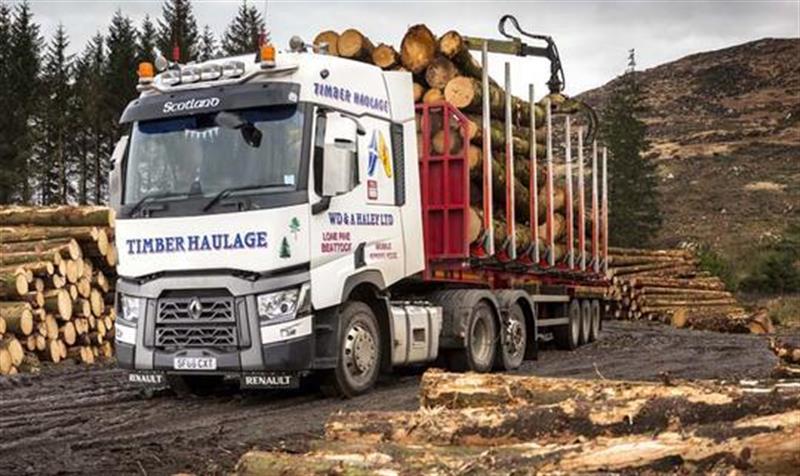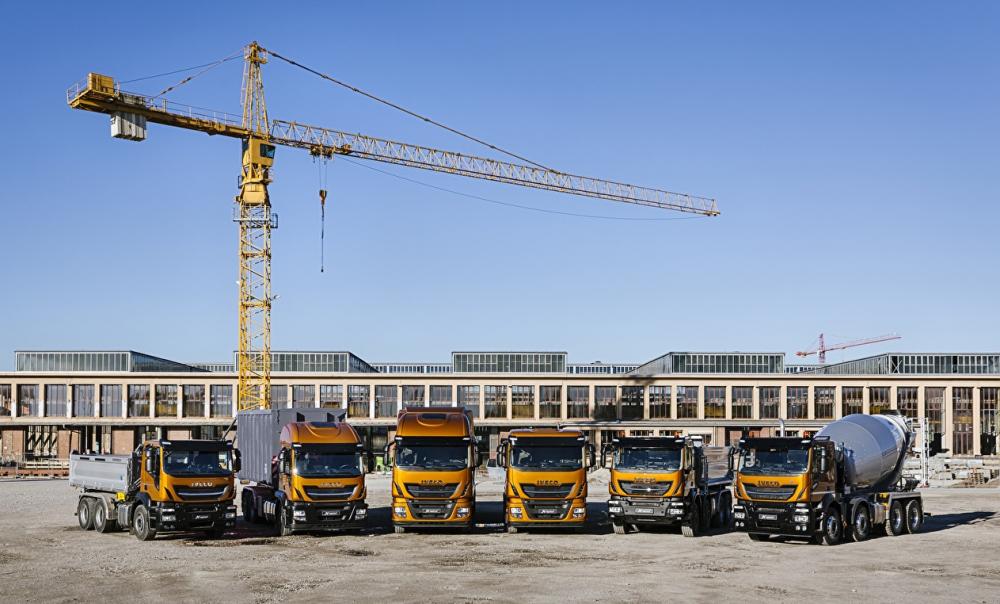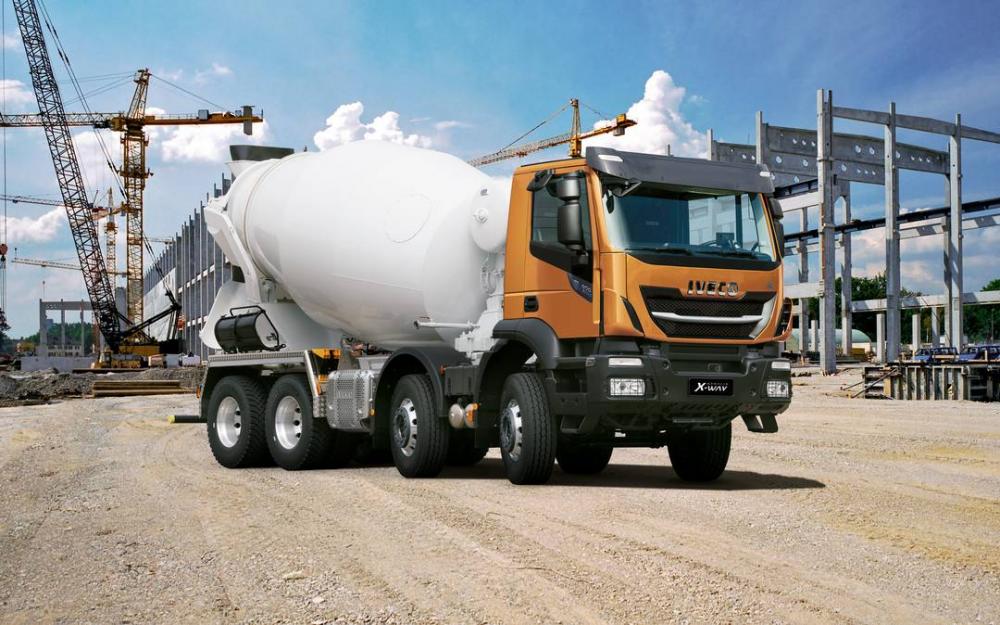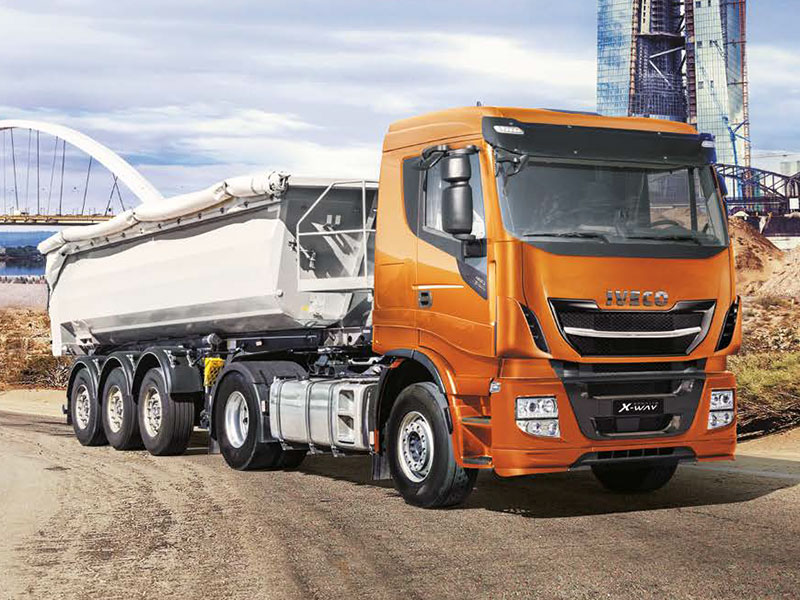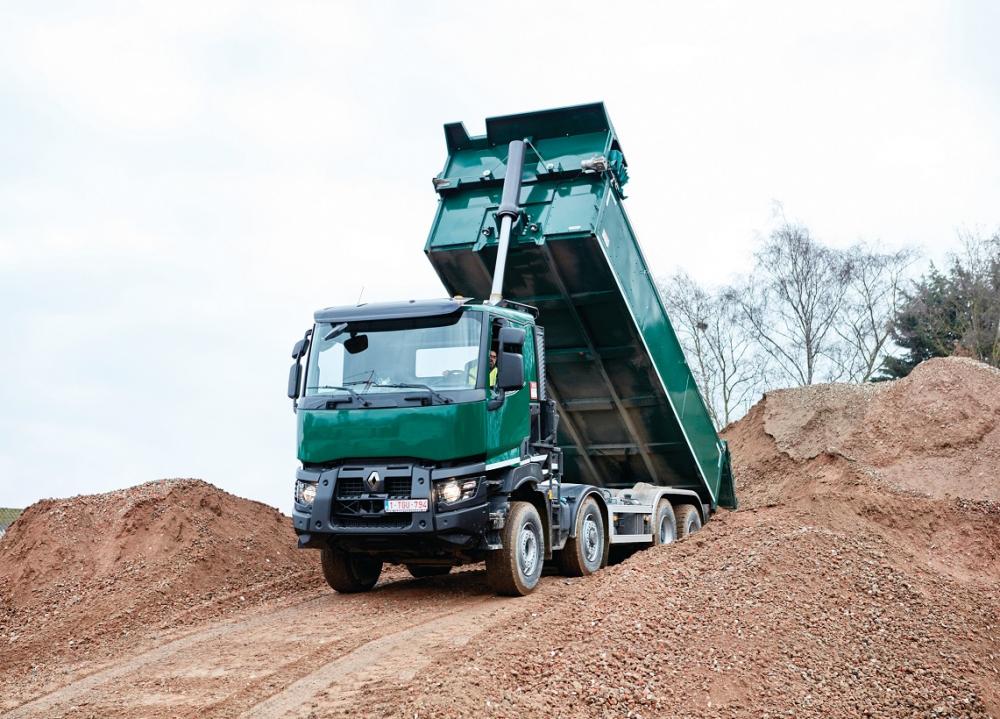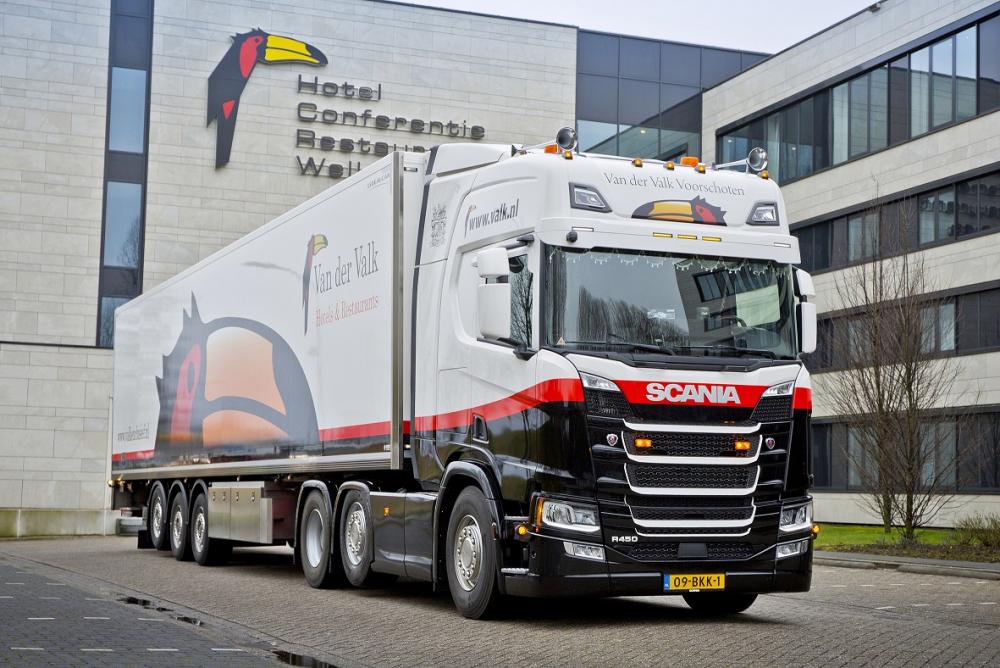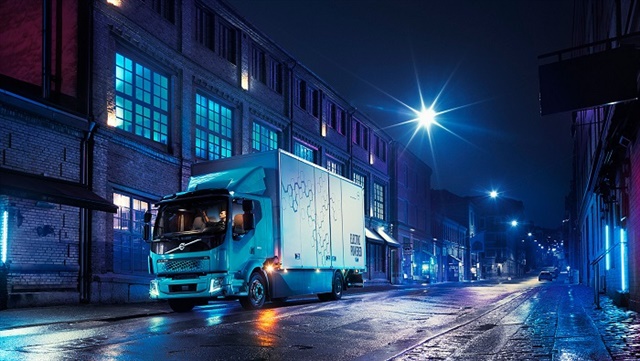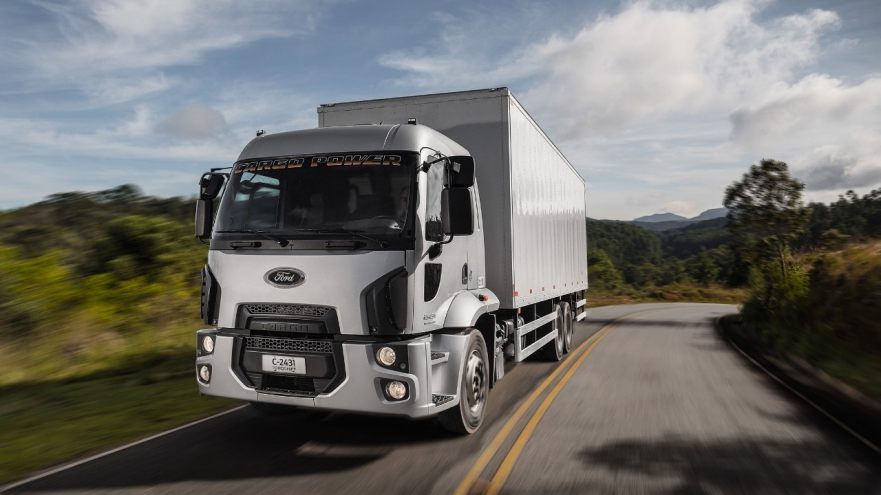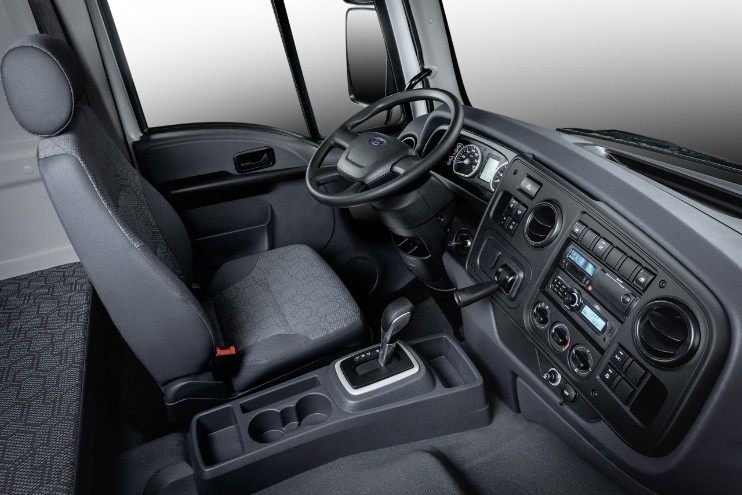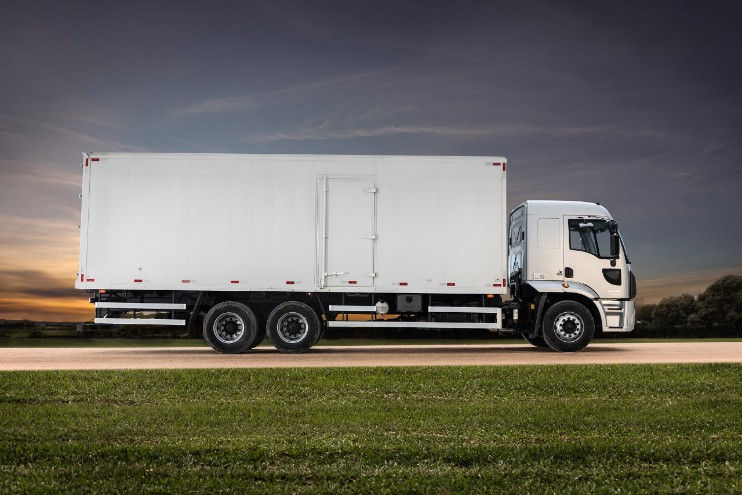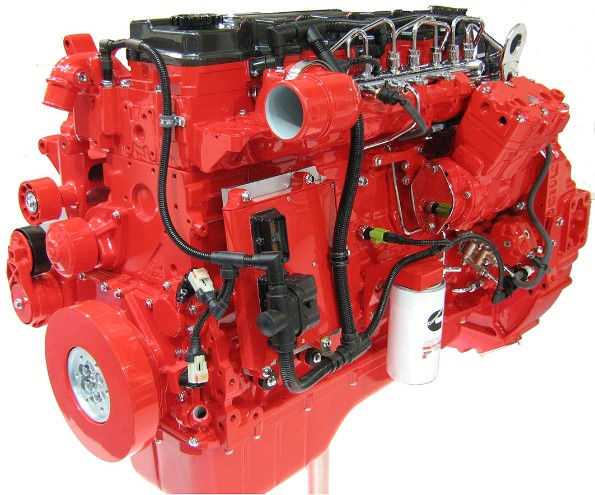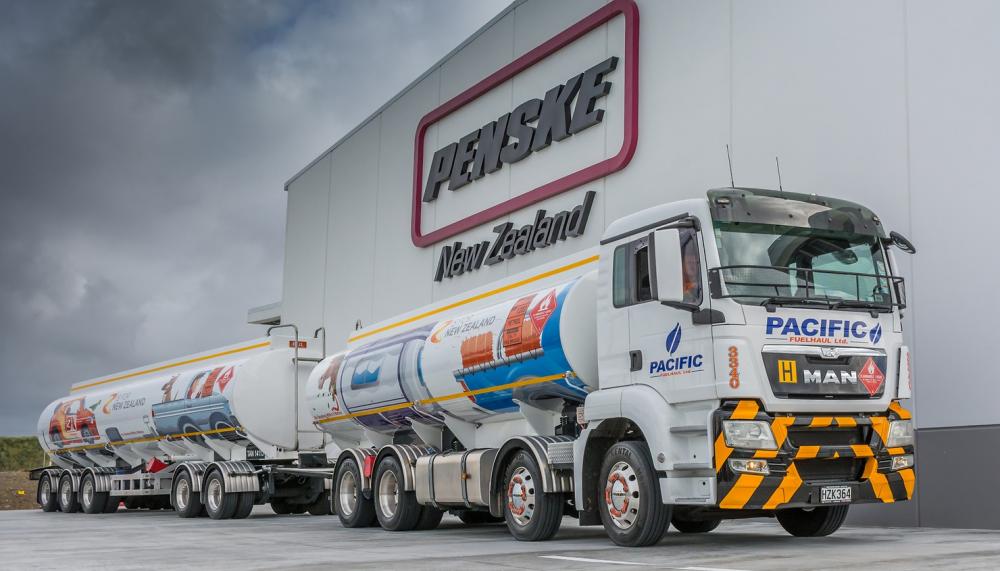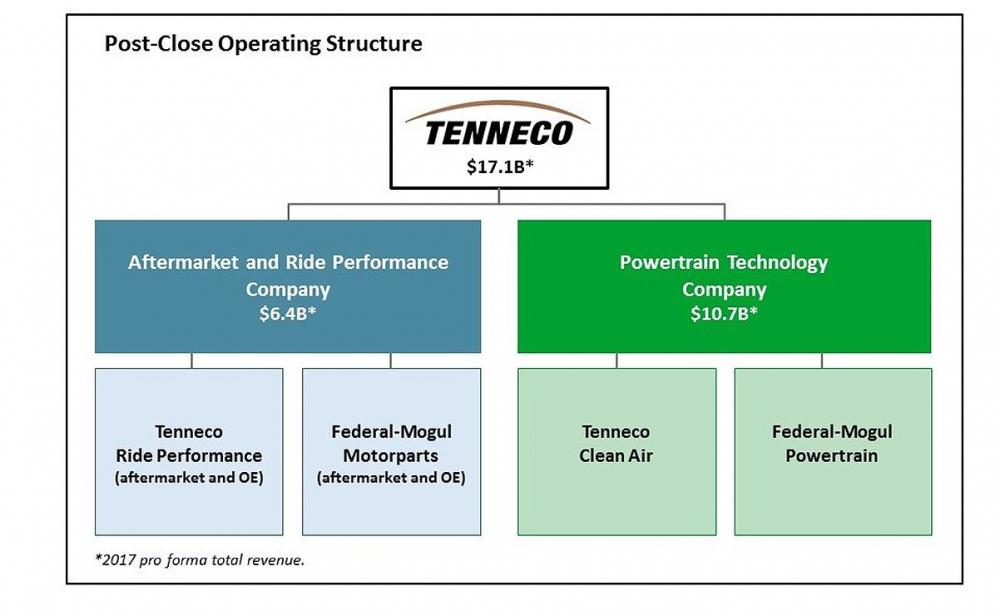
kscarbel2
Moderator-
Posts
18,923 -
Joined
-
Days Won
114
Content Type
Profiles
Forums
Gallery
Events
Blogs
BMT Wiki
Collections
Store
Everything posted by kscarbel2
-
Transport Engineer / April 12, 2018 Dumfriesshire-based forestry haulier WD & A Haley has taken delivery of two Range T520 tag axle tractors, its first vehicles of this type. Supplied by dealer Border Trucks Carlisle, the operator’s new additions have a 13-litre engine providing a maximum torque of 2550Nm, Optidriver automated gearbox, Alcoa Dura-Bright aluminium wheels and hydraulic power steering. They are hooked to logging industry skeleton trailers with timber bolsters, transporting 29 tonnes of logs at a time. The Range Ts are also equipped with a Bigfoot Tyre Deflation system, which allows drivers to control the air pressure in each tyre from the driving seat, giving extra traction and reducing damage to forestry roads. The operator has run Renault Landers, Premiums and Kerax in the past, but decided on the new additions after hearing “great reports” about the Range T, according to owner Antony Haley. Haley says: “Forestry work is tough, the landscape is awash with steep embankments and we needed something with plenty of grip and power. The T520s give us this by the ‘bucket-load’, coping skilfully with all types of terrain. “The tag axle is good for tight corners, too, and importantly gives us the traction on the hills and on difficult land.” He described the deal a “very competitive” and says he’s looking to add more to the seven-strong fleet. .
-
- 1
-

-
The medium-duty Freedom, based on the global market Renault Midlum*, was launched in 2001. * The Midlum was replaced by the D Range in 2013. Volvo took full control of Renault and Mack in 2001. In 2003, Volvo decided to terminate the Freedom and walk away from medium-duty in North America (Mack had profited greatly from the Renault-produced Mid-Liner medium truck range from 1979). So the Freedom was only sold for 3 years, and hasn't been sold for 15 years. Also, Volvo Group's unofficial policy is not to support trucks over 10 years of age. It's a great truck, but the owner of the Mack name, Volvo, has no interest in supporting it in North America. Renault Trucks does a superb job with after-sales support in the global market, but has no presence in North America.
-
Try calling the Mack brand at +1 (866) 298-6586. I'm sure Volvo will fall all over themselves trying to help you (sarcasm on my part). https://macktrucks.vg-emedia.com/ProductListing.aspx?keyword=freedom https://macktrucks.vg-emedia.com/ProductListing.aspx?keyword=MV You have what would be a good truck (Renault Midlum).......if acceptable after-sales support was still available in North America. It isn't......not even close. Candidly speaking, you should sell it at the first opportunity, as parts will always have to be ordered, cost a fortune, and most mechanics have no experience working on it. Let it break someone else.
-
Did you try obtaining a 202SB34A water pump repair kit and 57GC184 water pump gasket set from Watt's Mack (BMT website provider) at 1-888-304-6225?
-
The Trump show caves again......or were they ever actually serious about putting a stop to that "giant sucking sound"? .
-
At NAFTA table, U.S. lowers key auto content demand Reuters / April 13, 2018 MEXICO CITY -- U.S. trade negotiators have significantly softened their demands to increase regional automotive content under a reworked NAFTA trade pact in an effort to move more quickly towards a deal in the next few weeks, auto industry executives said on Friday. A deal on automotive content rules would remove one of the biggest sticking points in talks to update the 24-year-old North American Free Trade Agreement. The Trump administration had initially demanded that North American-built vehicles contain 85 percent content made in NAFTA countries by value, up from the current 62.5 percent, along with half the value coming from the United States -- levels that Canada, Mexico and automotive groups had said was unworkable. But the U.S. target has been cut by 10 percentage points, and the U.S. specific percentage demand dropped, industry officials said. "The U.S. put on the table 75 percent instead of 85 percent for the regional content value of the vehicle and its core components," said Eduardo Solis, head of Mexico's AMIA automotive industry association. "All of this is being carefully analyzed and specific questions are being asked during this round of the U.S. negotiators (in charge of) rules of origin," Solis said in a statement. The 75 percent regional content is for major components such as engines, drivetrains, axles, suspensions and body panels. Aluminum and steel would go into a bucket of other parts and materials requiring 70 percent regional content, while a third bucket of lesser parts would require 65 percent regional content. "From the parts manufacturer perspective this is a significant step in the right direction, compared to where we were," said Ann Wilson, head of government affairs at the Motor and Equipment Manufacturers Association. "But it does appear that this will creates significantly more paperwork for smaller suppliers to have to certify their parts," Wilson added. "I think there's a lot of room yet to improve this." Negotiators from the three nations were due to discuss the new U.S. proposals at talks this week in Washington. Talks on rules of origin were due to take place on both Friday and Saturday, according to a schedule seen by Reuters. A senior union leader who spoke to the Canadian negotiating team on Friday said the talks were progressing slowly. "We really still are far, far, far away on the issues that are keeping us apart and frankly there has been very little discussion on them this week," Unifor President Jerry Dias told Canada's CTV network, citing the U.S. stance on dispute resolution and labor standards. U.S. Trade Representative Robert Lighthizer has been pushing for a deal-in-principle on NAFTA in the next few weeks as the Mexico's presidential election campaign officially gets underway. President Donald Trump said on Thursday that he thought negotiators were "pretty close" to a deal, but that he was in no hurry for a conclusion. "Unless the United States makes some meaningful major changes in the short term, for anybody to think this is getting done by the end of April is pushing their luck," said Dias. U.S. negotiators had also recently floated the idea that 40 percent of automotive production must occur in areas paying wages of between $16 to $19 per hour. Some auto industry officials briefed on the U.S. plan said the latest version would require an average wage rate of $16 an hour for a finished vehicle. Setting wage minimum wage thresholds for the auto industry could benefit the United States and Canada, whose trade unions say that lower Mexican pay has prompted manufacturing capacity to move south of the Rio Grande. Talks to rework NAFTA, which underpins $1.2 trillion in annual trade, began last year after President Donald Trump took office promising to abandon the 1994 agreement if it could not be reworked to better serve American interests.
-
Iveco Truck & Bus Press Release / April 10, 2018 IVECO presents the new Stralis X-WAY and its sustainable vehicle ranges for the construction industry at Paris Intermat 2018 answering President Macron’s call for massive conversion of heavy truck fleets to gas IVECO showcases its wide offer of vehicles for the Road Building, Urban Construction, Recycling and Quarry sectors on the CASE Construction Equipment stand (Hall 6 Stand E 042) at Intermat 2018. IVECO presents its ranges of natural gas powered vehicles, answering President Macron’s call for the conversion of the country’s heavy truck fleets to gas at the European Commission’s High-level Conference on Financing Sustainable Growth held in Brussels on March 22nd 2018: “It is also about committing resolutely to a transformation of the transport sector, through a widespread use of electric and hydrogen vehicles and the conversion of heavy freight to gas.” The new Stralis X-WAY truck developed for construction logistics is the perfect answer for the ongoing boom in construction driven by the Grand Paris project. On display is its natural gas version, ideal for operating in Paris due to the city’s focus on curbing emissions. IVECO is taking part in the international exhibition for construction and infrastructure Intermat 2018 from the 23rd to the 28th April at the Parc des Expositions in Paris-Nord Villepinte, Paris. It is present on the CASE Construction Equipment stand, where it is showcasing its offering for every mission: Recycling, Urban, Road Building and Quarry. IVECO: the right vehicle for every mission The brand is presenting at the show the Stralis X-WAY, the new range specifically developed for construction logistics and urban service missions, which provides the perfect crossing for on-road applications requiring off-road mobility – taking the mission-oriented approach to the extreme. It combines IVECO’s best fuel-efficiency and safety technologies with the renowned off-road robustness of its toughest vehicles to deliver high productivity with best-in-class payload and outstanding Total Cost of Ownership. The area dedicated to Recycling highlights how IVECO and CASE offer a complementary range of products that make a perfect combination to achieve a circular economy based on the generation of bio-methane from waste. On display in this area is a Stralis X-WAY Hook Lifter, ideal for the recycling industry with its outstanding manoeuvrability, compact overall dimensions, ground clearance, traction and big payload. For the Urban sector, IVECO is presenting its sustainable Light Commercial Vehicles and trucks featuring its advanced alternative traction technologies, the natural gas powered Daily Blue Power – International Van of the Year 2018 – and the Stralis X-WAY NP (Natural Power). The brand is at the forefront of the industry with its pioneering sustainable solutions, which are increasingly in demand because of the fight against Climate Change and the issue of clean air in urban areas. Pierre Lahutte, IVECO Brand President, said: “IVECO’s commitment to supporting the energy transition has driven us to pioneer sustainable technologies, resulting in a full offering of alternative traction vehicles. At a time when municipalities are putting in place traffic restrictions and stringent emissions regulations to address the issue of air quality for their citizens, our natural gas powered vehicles give construction businesses a competitive advantage, especially when bidding for work in city centres.” The Stralis X-WAY NP on display in the urban area, combined with a CIFA electric mixer, is the first electric concrete mixer on a Bio-CNG truck. This vehicle not only delivers the advantages of extremely quiet operation and PM and CO2 emissions close to zero, but it also offers excellent operational features with an outstanding concrete load capacity of 8m3 – a capacity in line with the best diesel chassis. The Stralis X-WAY operates in a sector where payload is key, and in this respect it raises the stakes with the biggest payload in the segment. Its Super Loader version on an 8x4 chassis developed for concrete mixer applications weights in at less than 8,845 kg, taking the customers’ payload to new heights: it can carry 355 kg more load than the best vehicle certified by independent certification body UTAC. The new Daily Blue Power, which has been crowned “International Van of the Year 2018” , can access jobsites located in city centres round the clock, freeing construction businesses from the constraints of environmental regulations with its winning combination of technology, low emissions and environmental impact, high performance and efficiency. This new product family is IVECO’s Sustainability champion, delivering urban access with no limitation and giving customers the choice of three technologies: the Compressed Natural Gas powered Daily Hi-Matic Natural Power; the zero-emission Daily Electric and the Daily Euro 6 RDE 2020 Ready, the most advanced diesel technology in the industry. On display at the Intermat show, the Daily Hi-Matic Natural Power in the unique version of 7.2 ton Gross Vehicles Weight which allows a payload of up to 4,9 tons and a body length up to 6.4 meters with its 5.100 mm wheelbase. Its advanced sustainable technologies are combined with the historical strengths of the multi-award winning Daily family, which has built a solid reputation for its robustness, versatility, performance and durability. For the Road Building sector, IVECO is showing a Stralis X-WAY NP model, powered by the brand’s industry leading natural gas technology, which offers a further environmental advantage combined with the payload and performance benefits of the range – a benefit for construction logistics operations in urban centres with restrictions on diesel vehicles and job sites operating 24/7 with noise constraints. In the Quarry segment area of the stand, IVECO is displaying two vehicles: the Astra HD9 8x6 Euro VI and a Trakker, both in dumper configuration. The IVECO Astra range of vehicles is designed for heavy off-road applications in oil & gas, mining, quarrying, heavy construction and heavy haulage. Every single detail, from the high performance driveline, simple design electronics, has been developed to deliver the highest levels of performance, strength and reliability in the toughest jobs. At Intermat IVECO is introducing the new HD9 86.50 Euro VI featuring a full automatic transmission – a configuration that confirms the Off-Road DNA of the IVECO Astra product range with performances comparable to those of quarry and mining dumpers of the same payload, depending on the mission. The Trakker is engineered to work in all weathers and in all terrains – even the most extreme off-road conditions and combines robustness, reliability and efficiency with technology. The Trakker has repeatedly proved its legendary strength and durability on the most difficult terrains of the Dakar Rally. IVECO will also offer dynamic tests of several vehicles of the Stralis X-WAY range on the CASE Construction Equipment site in Monthyon, including a vehicle equipped with the new Hi-Traction system as well as vehicles in tipper, mixer and crane configurations. .
-
Renault Trucks Press Release / April 11, 2018 Renault Trucks is adding new features to its Optitrack system, designed to increase the pulling power of vehicles and maintain high performance whatever the terrain. The constructor is also providing an Optitrack+ version, incorporating new hydraulic motors for customers working in extreme conditions. Optitrack was developed by Renault Trucks in partnership with Poclain Hydraulics in 2009 and is available on the C2.5 range of vehicles, providing additional temporary pulling power thanks to two hydraulic motors fitted in the front wheel hubs. This system offers the possibility of benefiting from temporary all-wheel drive on demand, overcoming the constraints of a “conventional” all-wheel drive vehicle, particularly in terms of fuel consumption, loading height, maintenance costs and additional weight. Renault Trucks is now consolidating its Optitrack system by incorporating new features. Outstanding pulling power The hydraulic pressure of the system has been stepped up from 420 to 450 bars, leading to a 7% increase in the maximum wheel torque. This new feature boosts pulling power, enabling drivers to cope with the difficulties inherent in handling vehicles with high payloads or on steep terrain. In order to ensure maximum start-up power in the most demanding situations as well as total vehicle control, Renault Trucks has added a "boost" function. When activated by the driver, this increases front wheel tyre pressure to the maximum (450 bars) in order to achieve maximum start-up torque. Increased operating comfort and manœuvrability The Optitrack system disconnects when vehicle speed reaches 50km/h (compared to 40km/h on previous versions) and automatically re-engages at 20km/h, no longer requiring driver intervention. Finally, a self-calibration device permanently adjusts the settings of the Optitrack system, ensuring life-long vehicle performance, and an additional reverse gear has been added (R2) for optimal manoeuvrability on all types of terrain. Agility in all terrain with Optitrack+ Trucks operating in extreme conditions can now benefit from the features of the enhanced Optitrack+ version. Optitrack+ features new hydraulic motors that increase front wheel torque by 30 %. This enhanced version offers seamless pulling power for coping with high payloads, steep slopes and soft soil. Optitrack+ is particularly recommended for earthmoving or the transport of aggregate in difficult conditions. .
-
Iveco Truck & Bus Press Release / April 12, 2018 . . . .
-
Scania Group Press Release / April 13, 2018 The Dutch Van der Valk restaurant and hotel chain has recently acquired a new generation Scania R 450 as the latest addition to its all-Scania fleet. The investment is already paying off, with an average fuel consumption of only 28 litres per 100 km. Van der Valk’s Scania trucks deliver to more than 80 outlets throughout the Benelux countries and cover large distances with heavy loads and frequent delivery stops. Despite this demanding deployment, the trucks normally run for more than one million kilometres, with regular servicing every 120,000 kilometres. “For years, we’ve exclusively been driving Scania,” says Tom Vervloet, Manager of Van der Valk’s central cold storage warehouse near Leiden. “When we were in the market for a new truck at the end of last year, the decision was simple: Van der Valk and Scania belong together.” Scheduled maintenance controls costs The Van der Valk fleet transports goods from its cold storage distribution centre six days a week. “We carry all kinds of goods in our trailers: from fresh vegetables and meat to napkins, kitchen herbs and beer.” The new truck was specified as a 3-axle configuration with a tag axle. “We’ve always been heavy on the road and we have six to twelve delivery points per trip. With the previous 2-axle configuration we risked undue pressure on the driven rear axle after unloading at the first points.” Proper maintenance is important for Van der Valk. “In a way, this is internal distribution so we pay a lot of attention to costs. We have found that with good maintenance our vehicles can easily run 1.3 million kilometres without encountering problems.” Safety system for urban operation Two of the company’s trucks have passed the one million kilometre-mark and Tom Vervloet estimates that they can be gainfully operated another 10 years without affecting their overall condition, which is important since they are displaying the Van der Valk brand. “Scania’s reliability certainly plays a part in this. But achieving this mileage is also due to the fact that each truck has a regular driver assigned to it.” Although its drivers never sleep in the cab, Tom Vervloet opted for a high roof. “Van der Valk prides itself on a premium appearance. That’s why we haven’t saved on equipment and opted for the best leather seats, LED lighting, and a top-of-the line multimedia system. Safety isn’t overlooked either. “We often operate in urban areas with difficult manoeuvring while delivering. We therefore have a comprehensive camera system with blind-spot detection and a standard rear camera. And although I don’t have any hard figures, I’m fairly certain that the investment is paying off because we have very few claims.” With million-kilometre journeys ahead, it’s clear that when it comes to Scania, Van der Valk and its trucks are in it for the long haul. .
-
Heavy Duty Trucking (HDT) / April 12, 2018 The rapidly expanding world of electric trucks has a new player with an established reputation: Volvo has introduced its first all-electric truck for commercial use in Europe. The new Volvo FL Electric is designed for urban distribution and refuse operations, among other applications. The first trucks in the Volvo FL Electric range are now entering regular operation with customers in Gothenburg, Sweden, home of Volvo Trucks. Sales and series production of the new model are slated to begin in Europe next year. The first two Volvo FL Electric trucks will be operated by refuse collection and recycling company Renova and haulage firm TGM. According to Volvo, the FL Electric is a fully electrically-powered truck for distribution, refuse collection and other applications in urban conditions, with a GVW of 16 tons. Additional features include: A driveline comprised of a 185 kW electric motor: max power/130 kW continuous output, two speed transmission, propeller shaft, rear axle. Max torque electric motor 425 Nm. Max torque rear axle 16 kNm. Energy storage: 2-6 lithium-ion batteries, totalling 100–300 kWh. Range: Up to 300 km (186 miles). Charging: AC charging via the mains grid (22 kW) or DC fast charge via CCS/Combo2 for up to 150 kW. Recharging time: From empty to fully charged batteries: fast charge 1-2 hours (DC charging), night charge up to 10 hours (AC charging) with maximum battery capacity of 300 kWh. “We’re immensely proud to present the first in a range of fully electrically-powered Volvo trucks ready for regular traffic,” said Claes Nilsson, president Volvo Trucks. “With this model we are making it possible for cities that aim for sustainable urban development to benefit from the advantages of electrified truck transports,” “In order to make the transition secure and smooth, we will offer holistic solutions based on each customer’s individual needs regarding driving cycles, load capacity, uptime, range and other parameters,” added Jonas Odermalm, head of product strategy Volvo FL and Volvo FE at Volvo Trucks. “Such a solution may encompass everything from route analysis and battery optimisation to servicing and financing. Volvo Trucks works closely with several suppliers of charging equipment. The aim as always is to offer customers high uptime and productivity,” Backing the Volvo Trucks offer is the Volvo Group’s accumulated expertise in electrified transport solutions, the company said in a press release, noting that sister company Volvo Buses has sold more than 4000 electrified buses since 2010. Volvo said that the technology used for propulsion and energy storage in the Volvo FL Electric has been thoroughly tried and tested from the outset and is supported by Volvo Trucks’ network for sales, service and parts supply. .
-
Trump weighs rejoining TPP as he tones down China trade threat Bloomberg / April 12, 2018 WASHINGTON -- President Donald Trump told lawmakers he is considering rejoining the Trans-Pacific Partnership, the free-trade deal he withdrew from shortly after taking office, as he expressed confidence the U.S. is headed toward resolving trade conflicts without economic disruption. A week after escalating tensions with his threat to impose tariffs on an additional $100 billion in Chinese products, Trump said Thursday the two countries ultimately may end up levying no new tariffs on each other. “Now we’re really negotiating and I think they’re going to treat us really fairly,” Trump said during a White House meeting with Republican governors and lawmakers from farm states. “I think they want to.” The remarks were another conciliatory signal from the administration following tit-for-tat tariffs proposals from the world’s largest two economies that rattled markets. Trump also indicated that talks are progressing toward successful renegotiation of the North American Free Trade Agreement. After reporters left the room, Trump told the lawmakers he deputized economic adviser Larry Kudlow and U.S. Trade Representative Robert Lighthizer to explore re-entering the Asia-Pacific trade accord. Senator Ben Sasse told reporters of Trump’s remarks on the TPP, and two White House officials who spoke on condition of anonymity confirmed the statement. “He multiple times reaffirmed the point that TPP might be easier to join now,” said Sasse, a Nebraska Republican who participated in the meeting with Trump. The news drew a rebuke from opponents of the multilateral trade pact. AFL-CIO President Richard Trumka said on Twitter that TPP “was killed because it failed America’s workers and it should remain dead.” “There is no conceivable way to revive it without totally betraying working people,” he said. Trump withdrew the U.S. from the accord during his first week in office. The pact, which was conceived as a counterweight to China’s economic dominance in the region, had been negotiated under the Obama administration but never approved by Congress. The 11 remaining nations, representing 13 percent of global output including Japan and Canada, finalized a revised version of the trade pact last month, renaming it the Comprehensive and Progressive Agreement for Trans-Pacific Partnership or CPTPP. Trump suggested in February he was open to rejoining the trade bloc during a news conference with Malcolm Turnbull, the prime minister of Australia, which is in the CPTPP. One of the White House officials said that while the president prefers negotiating bilateral trade deals, a multilateral deal with the TPP countries would counter Chinese competition and would be faster than negotiating one-on-one with each of the 11 other nations. Open China In his remarks on Thursday, Trump cited a speech by Chinese President Xi Jinping that the U.S. president interprets as a signal China is about to open its markets to more U.S. goods. “He’s going to get rid of a lot of taxes and tariffs,” Trump said of Xi. Xi pledged a “new phase of opening up” Tuesday in a keynote address to the Boao Forum for Asia. While the speech offered little new policy and made no mention of Trump, Xi affirmed or expanded on proposals to increase imports, lower foreign-ownership limits on manufacturing and expand protection to intellectual property -- all issues central to the U.S. president’s trade complaints. Trump clearly regarded the remarks as conciliatory, and said again Thursday that it was a “good speech.” “Very thankful for President Xi of China’s kind words on tariffs and automobile barriers,” Trump said on Twitter on Tuesday. “Also, his enlightenment on intellectual property and technology transfers. We will make great progress together!” Talks stopped Talks between the world’s biggest economies broke down last week after the Trump administration demanded steps to curtail China’s support for high-technology industries, a person familiar with the situation said. The U.S. has accused China of unfairly subsidizing targeted sectors and forcing foreign companies to transfer technology in areas like robotics, aerospace and artificial intelligence. The U.S. hasn’t announced a date it intends to impose tariffs on an initial list of $50 billion in Chinese goods. The administration is also expected to release a separate list for additional proposed tariffs covering $100 billion in imports from China. On talks with Canada and Mexico to revamp NAFTA, Trump said negotiations are “coming along great,” though he added there’s no timeline to reach a deal. An agreement could be completed within a few weeks or five months, he said, adding “I don’t care.” The U.S. will come up with a good deal and “agriculture will be taken care of,” Trump said.
-
Trump threatens endless NAFTA talks amid softening U.S. stance on car content Bloomberg / April 12, 2018 WASHINGTON -- Donald Trump says he’s willing to “renegotiate forever” on NAFTA, a threat that comes as his trade office again softens its marquee demand for changes to the auto sector. The president, speaking Thursday at the White House, said renegotiation of the North American Free Trade Agreement with Canada and Mexico is progressing well but there isn’t a timeline for reaching a deal -- in part because the uncertainty of talks is already discouraging investment outside the U.S. “As long as we have this negotiation going, nobody’s going to build billion-dollar plants in Mexico,” Trump said. Despite his bluster, the U.S. has softened its negotiating position on the crucial issue of automotive content. American negotiators are now proposing that as much as 75 percent of car components be sourced from the three countries to quality for tariff exemptions under NAFTA, down from its initial proposal of as much as 85 percent, according to three people familiar with the matter, who spoke on condition of anonymity because the talks are private. The development was first reported by Inside U.S. Trade. It’s the latest concession by the Americans on the auto sector. The Trump administration is also said to have proposed tiers that allow more foreign content, while also dropping a demand for 50 percent U.S.-specific content. The three countries are running out of time to reach a deal that can be passed by the current U.S. Congress, while Mexican elections are also quickly approaching. Trump told U.S. lawmakers a NAFTA deal is close, according to Senator John Cornyn. Absent in Peru The developments also come as U.S. Trade Representative Robert Lighthizer, Trump’s point-man on NAFTA talks, scrapped a trip to the Summit of the Americas where he’d been due to meet with his Canadian and Mexican counterparts. Trump is also skipping the summit. U.S. demands for reforms to NAFTA’s auto sector rules have now changed substantially since being presented at the negotiating table last fall. Currently, 62.5 percent of a typical car and its major parts, and at least 60 percent of all parts, must be sourced from NAFTA countries to be traded tariff-free under the pact. Trump’s team at first proposed raising the content requirement to 85 percent, with a 50 percent U.S.-specific requirement. Its latest proposal envisions three tiers of parts, with the highest tier requiring 75 percent content, others requiring a lower level and no U.S.-specific requirement. Earlier this month it proposed five tiers. The U.S. president regularly singles out the auto sector as a victim of NAFTA’s status quo, and did so again Thursday by saying Mexico had “taken our auto industry by the throat.” Trump spoke while meeting with lawmakers from agricultural states, with major farm groups generally supportive of NAFTA. “We’re going to make it great and we’re pretty close to a deal. It could be three or four weeks, it could be two months it could be five months, I don’t care,” he said. “So the narrative of I’m pushing for a deal -- I never push for a deal. I don’t care. In fact if everybody in this room closed their ears I’d say that I’d rather terminate NAFTA and do a brand new deal but I’m not going to do that because I’d rather everybody to be happy in this room, okay? So we’ll see how it goes." The U.S. ambassador to Canada, Kelly Craft, said Thursday in Calgary she’s optimistic NAFTA can be fixed and the three nations will be able to modernize the decades-old deal. “We all want a good outcome, and if our past is any indication, I’m confident that we’re going to have a very bright future.”
-
1993 DM630S Dayton to Hub Piloted on front
kscarbel2 replied to jeremy.thames's topic in Driveline and Suspension
A Mack truck was a "custom built" truck. They were not all the same.....there were many, many variations. The only way to get the "correct" parts, i.e. the parts the truck would have been built with if spec'd with discs, is to have a changeover request submitted. Any other route is a guessing game. -
1993 DM630S Dayton to Hub Piloted on front
kscarbel2 replied to jeremy.thames's topic in Driveline and Suspension
Contact the parts dept. at your Mack brand dealer with your model and serial number, and have them submit a changeover request to Mack’s specifications dept. They will receive information allowing them to correctly order the parts required for you (the parts the truck would have had it been ordered/built that way. -
Ford Trucks Press Release / April 11, 2018 Ford Trucks launches the Cargo Power 2431 6x2, equipped with a new powertrain offering the best combination of performance and economy for maximum profitability With a gross weight of 24 metric tonnes, the 2431 is equipped with the new 306 horsepower version of the popular 6.7-liter Cummins ISB, the most powerful engine on the market up to 7 liters - and has the option of manual transmission or automated "Torqshift" AMT. TATUÍ, SÃO PAULO - Ford Trucks is launching the new Cargo Power 2431 6x2, featuring a new powertrain offering optimized performance and economy for maximum carrier profitability. "The new Cargo Power 2431 is a great launch that reinforces our proposal to bring innovative products to the market, with solutions focused on their real needs," says João Pimentel, director of Ford Trucks Operations in South America. The truck was developed based on customer feedback for a more powerful and efficient vehicle without giving up the economy, to be leader in the segment. " Launch Offer As a special launch offer, Ford will sell the first 500 units of the new 306-hp trucking for the same price as the 290-hp model. In addition, the brand provides a subsidized financing program for its entire 6x2 line, with special conditions that facilitate the acquisition. It is offered in the form of direct consumer credit (CDC) with a rate of 0.96% for payment in 48 months, with a 20% and 90 day grace period. Customer Voice The Cargo Power 2431 truck is produced in versions with 9-speed manual transmission or 10-speed Torqshift automated transmission. It was developed from an extensive research with transporters on the main routes of Brazil, improving the characteristics that they seek more in the performance of the vehicle. His project is the result of a two-year work that involved 400,000 miles of development and durability testing in both Brazil and in high altitude regions of South America using Ford Truck's extensive engineering expertise. The new ISB 6.7 engine, at 306 hp (@ 2,100 rpm) and 1,100 Nm torque, is the most powerful on the market in the 7-liter range and uses advanced technology to deliver high torque already at low speed, available in a wide range of 1,100 at 1900 rpm. With this, it ensures greater agility in the retakes and safety in the overtaking, with consumption equal or less than the competing models. Another advantage of the new engine is the emission treatment system with Arla [aka. AdBlue, DEF]. In addition to improving engine performance and durability, it has greater tolerance to fuel variability and a lower overall cost compared to competitors with the EGR system. Complete assistance The new Cargo Power 2431 has the complete after-sales service of the more than 100 Ford Truck distributors in Brazil, with a concept focused on speed, quality and fair price. The model features a new Ford Service maintenance package that offers three customer contract options, including revisions (Class), revisions and wear items (Plus) or complete assistance (Prime). Cargo Power also comes pre-factory with the Fordtrac enabled telemetry system, which includes monitoring and safety functions, and will have a monitoring center in the future to monitor the vehicle in real time with support staff. New line Cargo Power 2431 is the flagship of Ford's new Cargo and Power Cargo line, consisting of six models equipped with the new 306-hp engine and capacity from 17 to 31 tonnes gross total weight with 4x2, 6x2 , 6x4 and the unpublished 8x2, which will be presented shortly. It includes models: Cargo Power 1731 rigid, Cargo Power 1731T tractor, Cargo Power 2631 6x4, Cargo Power 3131 6x4 and Cargo Power 3031 8x2 with manual transmission or automated Torqshift. Ford will also continue to offer the 2929 6x2 Cargo 2929 option, which was the third-largest seller in the segment last year with 1,007 units. "Our goal with the launch of the Cargo Power line is to gain leadership in the 6x2 segment and achieve an average 25% stake in trucks with a hard chassis," said Guilherme Teles, Ford Truck's Marketing Manager. The brand works this year with a projection of growth of the order of 22% in the segment of trucks with rigid chassis and estimates an advance of 43.5% in the total of the industry, with 74,000 units. .
-
MAN Truck & Bus Press Release / April 3, 2018 Meeting the requirements of modern city transportation: the MAN EfficientHybrid. The new MAN Lion’s City is optionally available with an intelligent energy management system. The main component is a robust and wear-free electric motor which is installed in the driveline between the engine and the gearbox. Find more information on our website: https://go.man/7SjgkUvd .
-
MAN Truck & Bus Press Release / April 11, 2018 The perfect City Bus. We welcome the new MAN Lion's City Bus. .
-
MAN Truck & Bus Press Release / April 10, 2018 With the delivery of 36 new MAN vehicles, the New Zealand freight forwarder, TIL Logistics Ltd, has the largest MAN fleet in Australasia. It is made up of around 200 MAN trucks The delivery consisted of various models of MAN TGS and TGX vehicles between 480 and 540 hp Penske Commercial Vehicles is the supplier – MAN importer in Australia and New Zealand MAN is gaining prominence in the Australian and New Zealand market The New Zealand freight forwarder, TIL Logistics Ltd, which has its headquarters in New Plymouth, uses the 36 new MAN TGS Euro 5 models with M cab and MAN TGX models with XL cab for a range of different tasks. One of these tasks is transporting mineral oil. The maximum gross weight of the truck and trailer is 50 tonnes. The maximum length is 23 metres. The four-axle MAN TGS 35.540 8x4 BL tractor vehicle transports 20,000 litres of diesel. “Our drivers like the trucks, the fuel economy is a huge plus and I have received many comments about how great the trucks look – which is a big positive for our company image,” said a pleased Jim Ramsay, Managing Director of TIL Logistics Ltd. at the vehicle handover. “We knew that safety and technology features were important, as was reliability, fuel economy and low whole of life costs,” Dean Hovered of Penske New Zealand knew this from his long-standing business relationship with the freight forwarder. In January 2018, Penske Commercial Vehicles announced a new record for the Australian commercial vehicle market with 109 sales concluded. .
-
Matt Cole, Commercial Carrier Journal (CCJ) / April 10, 2018 Two separate recalls from Daimler Trucks North America and Navistar have resulted in more than 7,600 Western Star and International tractors being recalled, according to National Highway Traffic Safety Administration documents. DTNA is recalling approximately 7,128 model year 2017-2019 Western Star 4700, 4900, 5700 and 6900 trucks for a potential electrical issue. The affected trucks have a power stud that passes through the bulkhead, which could contact the bulkhead, resulting in an electrical arc. DTNA says an electrical arc can cause a fire. Daimler will begin notifying owners of affected trucks on May 21. Dealers will inspect the power stud for the proper clearance to the bulkhead and replace it if needed. Owners can contact DTNA customer service at 1-800-547-0712 with recall number FL-766. NHTSA’s recall number is 18V-191. Navistar also announced a recall that affects approximately 527 model year 2018-2019 International LT trucks. In the affected trucks, when the hood is closed, the fender splash panel could rub on the inlet fuel line fitting to the fuel/water separator, causing damage to the fitting and possibly resulting in a fuel leak. A fuel leak in the presence of an ignition can cause a fire, and fuel leaking onto the roadway can increase the risk of a crash, NHTSA says. Navistar will begin notifying affected truck owners on May 25. Dealers will trim the splash panel and replace the fuel/water inlet line if it is damaged. Owners can contact Navistar customer service at 1-800-448-7825 with recall number 18503. NHTSA’s recall number is 18V-199.
-
Chevy to launch all-new 2020 Silverado HD in fall 2019 Richard Truett, Automotive News / April 10, 2018 With profits from pickups more important than ever as sales of cars fade, Chevrolet is making sure one of its biggest cash cows won’t ever get old. Chevrolet said the next-generation Silverado HD will debut next year as a 2020 model. Chevrolet on Tuesday released the first teaser image of the 2020 heavy-duty Silverado. Heavy duty pickups, often kitted out with opulent luxury features, are some of the most profitable vehicles sold by General Motors, Ford and Fiat Chrysler Automobiles. Chevrolet has been left in the dust by Ford, which has opened up new market segments with such vehicles as the ultraluxurious F-450 Super Duty Limited 4X4, which can top six figures once sales taxes are added. In addition to consumer versions of the Silverado 2500 and 3500, Chevrolet is moving to directly challenge Ford with all-new versions of Silverado 4500 and 6500 chassis cab medium-duty trucks. These models are sent to upfitters who use the chassis for ambulances and other commercial vehicles. Ram offers a 4500 chassis cab model. The 2020 Silverado HD will be built in Flint, Mich., and production is scheduled to start in the third quarter of 2019, Chevrolet says. Ram also plans to offer a freshened version of its heavy-duty pickup next year.
-
Automotive News / April 10, 2018 Automotive supplier Tenneco Inc. has reached a definitive agreement to acquire Federal-Mogul in a transaction valued at $5.4 billion. The deal, which will be financed through $800 million in cash, about 30 million Tenneco shares and assumption of debt, will result in two independent publicly traded companies following closing, Lake Forest, Ill.-based Tenneco said in a news release. The acquisition is expected to close in the second half of this year, subject to regulatory approvals, with the separation occurring in the second half of 2019. "This is a landmark day for Tenneco with an acquisition that will transform the company by creating two strong leading global companies, each in an excellent position to capture opportunities unique to their respective markets," Tenneco CEO Brian Kesseler said in the release. "Federal-Mogul brings strong brands, products and capabilities that are complementary to Tenneco's portfolio and in line with our successful growth strategies. Unleashing two new product focused companies with even stronger portfolios will allow them to move faster in executing on their specific growth priorities." The transaction stands to shake up the world of aftermarket parts retailing. Federal-Mogul's parts portfolio features numerous household names such as Champion spark plugs, Wagner brakes, ANCO wiper blades, Moog steering and suspension parts, Goetze engine parts and Ferodo brake pads. Popular brands under the Tenneco portfolio include Monroe shock absorbers, Walker exhaust systems, Rancho suspensions and DynoMax mufflers. The two new companies will be born after the union of Tenneco and Federal-Mogul -- one a $6.4 billion aftermarket supplier and the other a $10.7 billion powertrain technology supplier, the company said. Following the split, it's expected that headquarters for each company will remain in the Detroit and Chicago areas, but a decision on which one would go where has not been made, Bill Dawson, executive director of communications for Tenneco, said in an email. No determinations on maintaining workforce have been made, Dawson said, but noted the companies don't overlap on products. "It's too early to talk about any integration changes, but it is important to remember that Tenneco's and Federal-Mogul's products and technologies are highly complementary," Dawson said in a email. "We do not manufacture or engineer the same products as Federal-Mogul's Motorparts and Powertrain businesses." Tenneco shares rose 4 percent to close the day at $57.82. More than a century Federal-Mogul has a long history. The company traces its roots to 1899, the founding year for the Muzzy Lyon Co., which sold mill supplies and rubber goods, but shortly thereafter began a metalworking subsidiary to make bearings. Federal-Mogul was formed in 1924, when Muzzy-Lyon merged with Federal-Bearing and Bushing. The Tenneco deal is the latest among a trend of suppliers splitting themselves. Aptiv Plc and Delphi Technologies Plc formed as a result of the former Delphi Automotive Plc breaking up last year. Autoliv Inc., the Swedish-American airbag and seatbelt maker, is spinning off its driverless-electronics business and Germany’s Continental AG is considering a shakeup of its structure. The transaction also is reminiscent of the megamerger between global chemical giants DuPont Co. and Dow Chemical Co., which closed in September 2017. The transaction calls for splitting DowDuPont into three companies focused on agricultural products, materials and chemicals, and technology-based special products. The company said it aimed to complete the split in 18 months from closing. Icahn's role The deal marks a major payoff for billionaire investor Carl Icahn, who has sought to monetize his investment in Federal-Mogul since 2007, when he purchased unsecured Federal-Mogul bonds before its bankruptcy and eventually swapped them for equity as part of the company's reorganization plan. In early 2017 and after nearly a year of posturing with Federal-Mogul's shareholders, Icahn took full ownership of Federal-Mogul in a roughly $300 million deal. Icahn Enterprises LP, through his indirect wholly owned subsidiary IEH FM Holdings LLC, sealed the deal after Federal-Mogul's second-largest shareholder, Gabelli Asset Management Company Investors, tendered 7 million shares to Icahn, providing enough shares to take over the public company outright, Bloomberg reported. "Icahn Enterprises acquired majority control of Federal-Mogul ... when we saw an out-of-favor market opportunity for a great company," Icahn said in a statement. "During that time, we have built one of the leading global suppliers of automotive products. I am very proud of the business we have built at Federal-Mogul and agree with Tenneco regarding the tremendous value in the business combination and separation into two companies. We expect to be meaningful stockholders of Tenneco going forward and are excited about the prospects for additional value creation." Tenneco posted $9.27 billion in total revenue in fiscal 2017 and reported net income of $274 million. Together, General Motors and Ford Motor Co. comprised more than a quarter of the company's sales last year. Federal-Mogul posted $7.43 billion in total sales in 2016 and $82 million in net income, the latest year available. In 2015 it had a $110 million loss, and a $168 million loss in 2014. None of Federal-Mogul's customers in 2016 accounted for more than 10 percent of its overall revenue, the company said in its annual report. Tenneco ranks No. 31 on the Automotive News list of the top 100 global suppliers with worldwide sales to automakers of $7.35 billion in 2016. Federal-Mogul ranks No. 46 on that list, with estimated sales to automakers of $5.16 billion in 2016. .
-
When you contacted your Mack brand dealer, what did they say?
BigMackTrucks.com
BigMackTrucks.com is a support forum for antique, classic and modern Mack Trucks! The forum is owned and maintained by Watt's Truck Center, Inc. an independent, full service Mack dealer. The forums are not affiliated with Mack Trucks, Inc.
Our Vendors and Advertisers
Thank you for your support!


